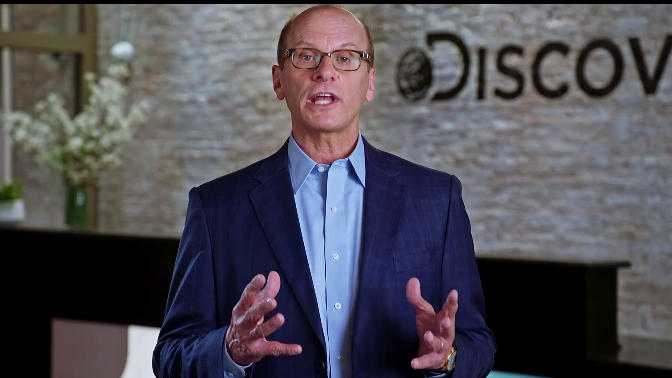Discovery Taking on Broadcast Nets in Upfront with Premiere
Streaming on new Go app and Discovery Plus provides reach

Discovery moved its upfront to the week when broadcasters make their pitches to ad buyers because it no longer wants to compete against other cable networks.
“We have surpassed our cable competitors and today we stand shoulder to shoulder with the broadcast networks," said Jon Steinlauf, chief U.S. advertising sales officer.
In addition to its cable networks, Discovery is offering ad buyers its streaming service Discovery Plus and will be changing the 15 Go apps that let authenticated viewers with pay-TV subscriptions stream Discovery networks' shows, including series created for digital. Later this year, users of each app will be able to access programming from all 15 Discovery networks.
Steinlauf made that declaration before even before AT&T agreed to spin off its WarnerMedia unit and merge it with Discovery. When that deal closes it will bring more networks and more scale to the Discovery portfolio.
Discovery is also getting ready to roll out Chip and Joanna Gaines's Magnolia Network and has created a special Equity & Inclusion Solutions ad package.
(Who will program and sell those networks is still to be decided by Discovery CEO David Zaslav, set to run the combined company. Zaslav opened the upfront, welcoming advertisers to "day one of Discovery's new adventure.")
Discovery’s big weapon in taking on the broadcasters is the Discovery Premiere bundle created by Steinlauf three years ago.
The smarter way to stay on top of broadcasting and cable industry. Sign up below
Also Read: Discovery Using iSpot To Measure Cross-Platform Ad Campaigns
Discovery Premiere offers advertisers commercials in the first run of the top rated shows on Discovery’s networks. Discovery’s networks has more shows that generate a 1 ratings in the sales demos than broadcast networks have, and their prices on a cost-per-thousand viewers basis is lower.
“We already have over a hundred advertisers on in the second quarter and we’ve tripled our ad revenue on Discovery Premiere in the second quarter of 2021 compared to the second quarter of 2020,” Steinlauf said.
Discovery Premiere offers advertisers reach because its shows run on a variety of networks -- HGTV, Food Network, Discovery, TLC, OWN, ID -- that have different audience profiles.
During this upfront Steinlauf said it will be encouraging advertisers to shift from buying based on age-based demos that don't count older viewers. Counting 55 plus viewers increases the supply of impressions Discovery has to sell and those consumers have a huge amount of purchasing power.
Discovery Plus enhances reach even more because it has a disproportionately high share of subscribers in non-cable homes, he added. “Every time you step into another platform, you’re getting new audiences.”
Overall, Steinlauf notes that the broadcast proposition has eroded. Ratings are down and there is far less scripted programming on the broadcasters. Instead, the schedule is filled with game shows, newsmagazine, variety and competition shows and more reruns.
The drop in scripted shows is partly because of the way the pandemic hit Hollywood, disrupting production. But it’s also the result of the big media companies shifting their focus to building their streaming services.
“When NBC develops the next This Is Us, where does it go? Does it go to Peacock or does it go to NBC,” Steinlauf asks.
At the same time, broadcast prime time is the most expensive advertising inventory and prices are likely to be up sharply in this upfront, partly because of a tight supply of scarce ratings points and the return of some COVID-affected categories to the market.
“The bar is very high,” Steinlauf said. Buyers “have to look at the product that the broadcasters are putting on the air and see how does this hold up to the legacy pricing of broadcast prime.”
But brands and buyers looking to shift their ad dollars form broadcast to streaming might be in for a rude surprise because supply is tight there too.
“If you’re looking for high-quality television and film in the streaming space, you don’t have a lot of options,” he said because Netflix and Disney Plus don’t take ads and. Hulu, the top ad-supported streamer is largely sold out.
“Maybe TV was too much of a bargain for too long and it may be streaming needs more years to grow bigger,” he said.
Jon has been business editor of Broadcasting+Cable since 2010. He focuses on revenue-generating activities, including advertising and distribution, as well as executive intrigue and merger and acquisition activity. Just about any story is fair game, if a dollar sign can make its way into the article. Before B+C, Jon covered the industry for TVWeek, Cable World, Electronic Media, Advertising Age and The New York Post. A native New Yorker, Jon is hiding in plain sight in the suburbs of Chicago.

